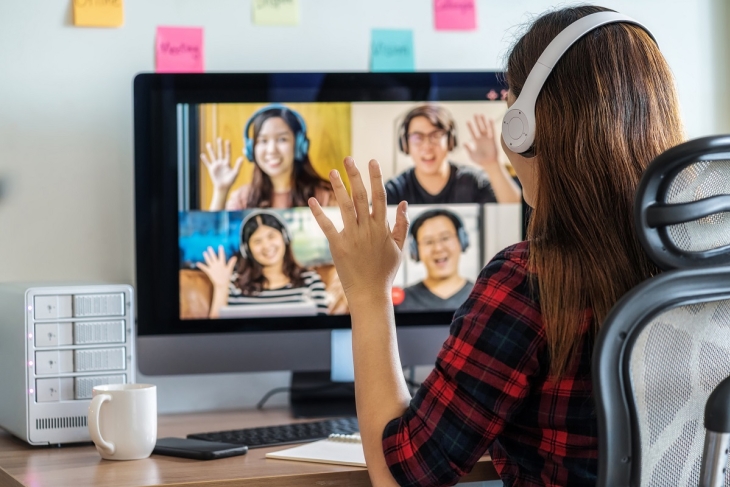Stories of successful remote teaching and learning experiences during the pandemic are heartening. But more and better data around those successes are required. Evidence suggests that districts will likely continue some level of Covid-era remote learning for the near future, and that old-school virtual charters have drawn in many new families who discovered their need for them in 2020. Anecdotes of successful pandemic pivots are not enough. A new report published in the Journal of Microbiology & Biology Education is a good start at building the vital knowledge base of how best to conduct virtual learning. The data come from the perspective of higher education but many of the lessons are transferrable to K–12.
The three co-authors of the report are all professors at New York University, teaching undergraduate seminar-style biology courses, each enrolling about twenty-five students. All three had to adapt their traditional courses to fully-remote models, taught from their homes to students in their homes located around the world. The instructors’ desire to maintain quality and rigor in their courses while pivoting to remote teaching drove them to reassess their learning objectives—derived from the K–12 Next Generation Science Standards—determining that some could only be communicated and achieved through synchronous, real-time instruction, while others could be successfully met via asynchronous, self-paced coursework. They also needed to revamp their course materials to make them fully accessible to students in the remote mode. Finally, a number of new technology platforms were required to ensure full participation and collaboration among students and with their instructors.
The adaptations required were endless. For example, an experiential learning project—in which students identify twenty unique plant species in their local environment to observe the effects of biodiversification—included changes to cover lack of Wi-Fi in the field, varying access to personal technology, extreme differences in students’ local environments around the world, and even differing levels of pandemic lockdown protocol ongoing in various countries. A number of off-the-shelf remote learning tools were employed to help maintain student progress in the asynchronous effort and to facilitate the group work required. Final presentations were recorded and viewed via Zoom, and while live feedback did not occur, each student was required to view and comment on all the presentations in writing via a Google form.
In a second example, the professors initially thought one of several existing, open-source virtual labs could be used to replace their typical Mendelian genetics project. However, these were found to cover only non-human genetics and did not feature face-to-face phenotyping, both of which had been found to be important for successful student engagement and information retention in the course previously. Pivoting, a synchronous Zoom session which largely approximated the typical classroom version was substituted. This included phenotyping in pairs, individual data analysis, and a full group session to discuss findings. A handful of students unable to attend synchronously completed their work individually on their own time and were able to view a recording of the group discussion.
What does all this amount to? On the upside: Certain learning targets, such as understanding biodiversity and adaptation to various environments, were enhanced by the geographic spread of students. The need for different versions of course materials led the professors to reinvent those materials in positive ways which will help improve access to them in the future. And the pandemic itself, including rapidly-evolving data and misinformation, provided a strong “hook” for group projects on real-world biology concepts.
On the downside: Working with unfamiliar software and modules sometimes put the focus on troubleshooting rather than learning for both teachers and students, varying student access to Wi-Fi and sufficiently powerful devices led to an occasionally unequal experience of the class, and extreme time-zone variations rendered full class synchronization impossible. Luckily, such time zone issues rarely bedevil remote learning in the K–12 space. And it is to be hoped that between philanthropic, state, and federal efforts spurred by the pandemic, internet and enabled-device access will be a quickly-shrinking problem for our schools moving forward.
But the biggest roadblock to the highest quality remote learning identified here and elsewhere is a lack of live personal feedback. Kudos to the NYU professors for their clever adaptations and creative thinking to create virtual conversations—and a hearty welcome back for the old school online message board—but live Q. and A. among students and teachers was largely absent for a variety of reasons. This is the life blood of lecture and seminar classes, a non-negotiable element that must be faithfully replicated if fully-remote learning is to have a permanent and effective place in formal education.
It is unfortunate that the professors did not compare student outcomes between their traditional seminar and the Covid-adapted version. It was likely a deliberate omission with no explanation provided. Such data are, ultimately, what are required to make certain that remote learning efforts properly replicate traditional classroom rigor. However, the details provided here are a useful step forward.
SOURCE: Erin S. Morrison, Eugenia Naro-Maciel, and Kevin M. Bonney, “Innovation in a Time of Crisis: Adapting Active Learning Approaches for Remote Biology Courses,” Journal of Microbiology & Biology Education (May 2021).




